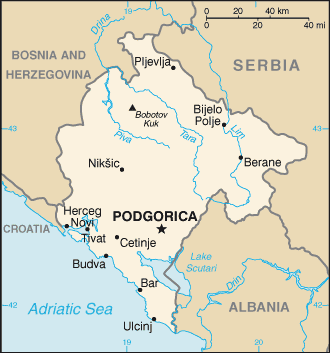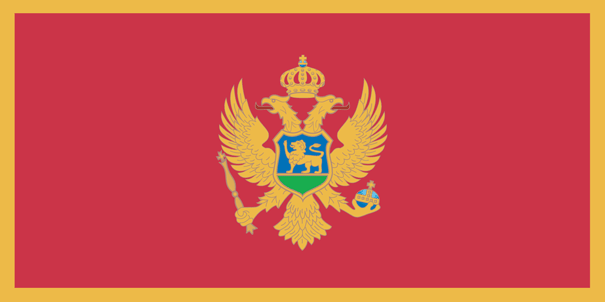
|
Montenegro
Background:
The use of the name Montenegro began in the 15th century when the Crnojevic
dynasty began to rule the Serbian principality of Zeta; over subsequent
centuries Montenegro was able to maintain its independence from the Ottoman
Empire. From the 16th to 19th centuries, Montenegro became a theocracy ruled by
a series of bishop princes; in 1852, it was transformed into a secular
principality. After World War I, Montenegro was absorbed by the Kingdom of
Serbs, Croats, and Slovenes, which became the Kingdom of Yugoslavia in 1929; at
the conclusion of World War II, it became a constituent republic of the
Socialist Federal Republic of Yugoslavia.
Location:
Southeastern Europe, between the Adriatic Sea and Serbia
Area: total: 14,026 sq km.
land: 13,812 sq km.
Area - comparative: slightly smaller than Connecticut.
Land boundaries: 625 km, border countries: Albania 172 km, Bosnia and
Herzegovina 225 km, Croatia 25 km, Serbia 203 km.
Climate and Terrain:
Climate: Mediterranean climate, hot dry summers and autumns and relatively cold
winters with heavy snowfalls inland.
Terrain: highly indented coastline with narrow coastal plain backed by rugged
high limestone mountains and plateaus.
Natural resources: bauxite, hydroelectricity.
People:
Population: 630,548.
Ethnic groups: Montenegrin 43%, Serbian 32%, Bosniak 8%, Albanian 5%, other
(Muslims, Croats, Roma (Gypsy)) 12%.
Religions: Serbian Orthodox, Muslim, Roman Catholic, Protestant .
Languages: Serbian (official; Ijekavian dialect), Bosnian, Albanian, Croatian.
Government:
Government type: Republic.
Capital: Podgorica.
Independence: 3 June 2006 (from Serbia and Montenegro).
Economy overview:
On January 18, 2007, Montenegro joined the World Bank and IMF. Montenegro is
pursuing its own membership in the World Trade Organization as well as
negotiating a Stabilization and Association agreement with the European Union
in anticipation of eventual membership. Severe unemployment remains a key
political and economic problem for this entire region. Montenegro has
privatized its large aluminum complex - the dominant industry - as well as most
of its financial sector, and has begun to attract foreign direct investment in
the tourism sector.
Statistics:
Telephones - main lines in use: 177,663.
Telephones - mobile cellular: 543,220.
Radio broadcast stations: 31.
Internet users: 50,000.
Railways: Total: 41,135 km.
Highways: Total: 7,353 km, paved: 4.274, unpaved: 3,0390 km.
Airports - with paved runways: 3, with unpaved runways: 2
Return to Visiting Locations
|

